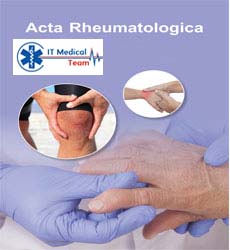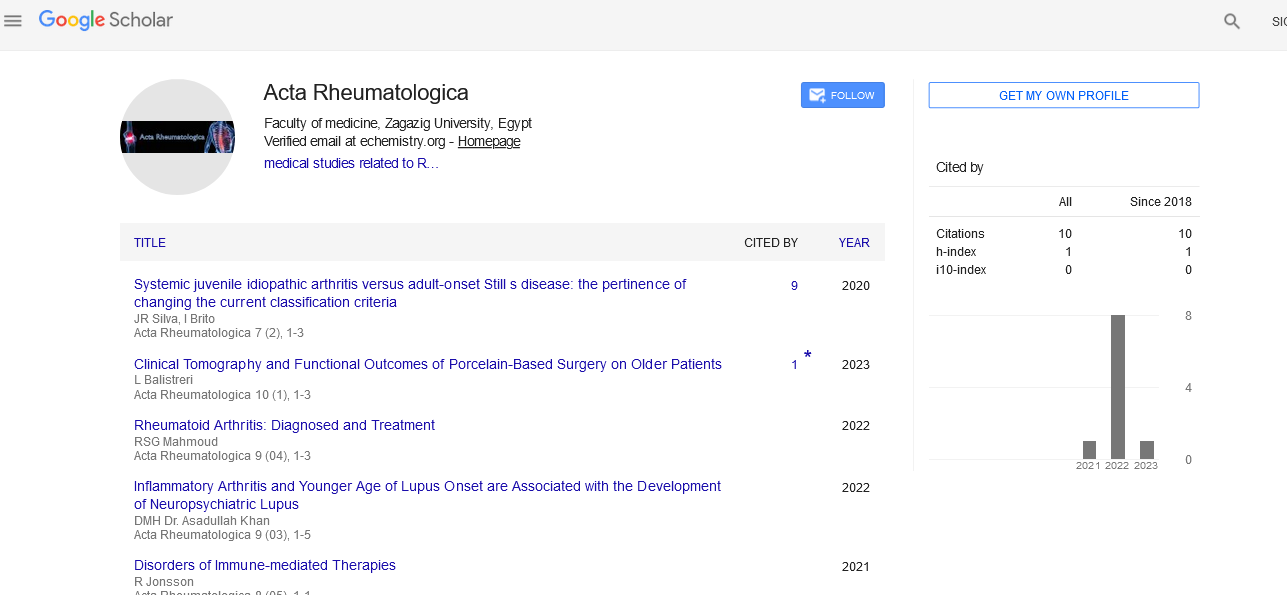Case Report - (2023) Volume 10, Issue 4
Enhancing Patient Outcomes through Comprehensive Healthcare Strategies
Shaokoon Cheng*
Department of Rheumatology, Australia
*Correspondence:
Shaokoon Cheng, Department of Rheumatology,
Australia,
Email:
Received: 03-Aug-2023, Manuscript No. ipar-23-14033;
Editor assigned: 05-Aug-2023, Pre QC No. ipar-23-14033(PQ);
Reviewed: 19-Aug-2023, QC No. ipar-23-14033;
Revised: 22-Aug-2023, Manuscript No. ipar-23-14033(R);
Published:
28-Aug-2023
Abstract
This article delves into the intricate realm of patient outcomes
enhancement within modern healthcare. A compilation of factors
contributing to optimized patient care is presented, ranging from holistic
patient-centered approaches to groundbreaking precision medicine
initiatives. The integration of telehealth services and remote monitoring,
coupled with the power of interdisciplinary collaboration, is explored
as an avenue to foster improved patient outcomes. The transformative
impact of health information technology, including electronic health
records and clinical decision support systems, is underscored. Preventive
care and health promotion strategies are also discussed in light of their
pivotal role in reducing chronic disease prevalence. This comprehensive
exploration highlights the amalgamation of innovative methodologies
that collectively pave the way for a future marked by superior patient
outcomes and a heightened quality of life.
Keywords
Patient outcomes; Healthcare strategies; Holistic care;
Patient-centered approach; Precision medicine
INTRODUCTION
In the dynamic landscape of modern healthcare, the
pursuit of optimal patient outcomes stands as a paramount
objective. With the continuous evolution of medical
knowledge, technological advancements, and innovative
treatment modalities, the quality of care and prognosis for
patients has undergone remarkable improvements across
a spectrum of conditions [1]. As healthcare providers,
researchers, and policymakers strive to further refine and
elevate patient care, the quest for innovative strategies
becomes ever more crucial [2]. This article delves into
the core principles that contribute to enhanced patient
outcomes and explores a diverse array of approaches aimed
at achieving superior healthcare results. By examining the
intricate interplay of factors that influence patient wellbeing,
we gain insights into the multifaceted nature of
modern healthcare strategies that underpin the realization
of improved patient outcomes [3].
DISCUSSION
The pursuit of better patient outcomes lies at the heart
of modern healthcare. Advances in medical knowledge,
technology, and treatment modalities have significantly
improved the quality of care and the prognosis for patients
across a wide spectrum of conditions [4]. Healthcare
providers, researchers, and policymakers are continuously
seeking innovative strategies to further optimize patient
outcomes and ensure that individuals receive the best
possible care. In this article, we will explore the key factors
that contribute to enhanced patient outcomes and examine
various approaches to achieving improved healthcare
results.
Holistic patient-centered care
One of the fundamental principles underpinning the
improvement of patient outcomes is the shift towards
a holistic patient-centered approach. This approach
recognizes that patient care extends beyond mere medical
interventions and encompasses the patient's physical,
emotional, and psychological well-being [5]. By addressing
all dimensions of a patient's health, healthcare providers
can better understand and meet the unique needs of each
individual. Incorporating patient preferences, values, and
cultural backgrounds into treatment plans fosters a stronger
doctor-patient relationship, leading to improved adherence
to treatment regimens and ultimately better outcomes.
Precision medicine
Precision medicine has emerged as a groundbreaking
approach that tailors medical care to the specific genetic,
molecular, and environmental characteristics of each
patient. Through genomic sequencing and advanced
diagnostics, healthcare providers can identify genetic
markers that influence disease susceptibility, progression,
and treatment response [6]. This personalized approach
allows for the selection of targeted therapies that are
more likely to be effective, minimizing adverse effects
and optimizing treatment outcomes. Precision medicine
has particularly transformed the management of cancer,
enabling oncologists to select therapies based on the unique
genetic profile of a patient's tumor [7].
Telehealth and remote monitoring
The rapid advancement of technology has facilitated
the expansion of telehealth services and remote patient
monitoring. Telehealth allows patients to access medical
consultations and follow-up care from the comfort of their
homes, eliminating geographical barriers and improving
healthcare access [8]. Remote monitoring devices, such
as wearable sensors and mobile applications, enable
continuous tracking of vital signs, medication adherence,
and disease progression. This real-time data empowers
healthcare providers to detect potential complications
early and intervene promptly, leading to better disease
management and reduced hospitalizations.
Interdisciplinary collaboration
Enhancing patient outcomes requires a collaborative effort
among various healthcare disciplines. Multidisciplinary
teams, comprising physicians, nurses, pharmacists, social
workers, and other specialists, collaborate to provide
comprehensive care that addresses all aspects of a patient's
health [9]. This approach is particularly effective for
managing complex, chronic conditions that require a
multifaceted treatment strategy. By leveraging the expertise
of diverse professionals, healthcare providers can develop
well-rounded care plans that improve patient outcomes
and quality of life.
Health information technology
The adoption of health information technology, including
electronic health records (EHRs) and clinical decision
support systems, has revolutionized patient care. EHRs
facilitate seamless sharing of patient information among
healthcare providers, reducing duplication of tests and
improving care coordination. Clinical decision support
systems analyze patient data to provide evidence-based
treatment recommendations, enhancing the accuracy and appropriateness of medical interventions [10]. These
technological tools empower healthcare providers with
timely and relevant information, leading to more informed
clinical decisions and better patient outcomes.
Preventive care and health promotion
Prevention is a cornerstone of improved patient outcomes.
Emphasizing preventive care and health promotion
initiatives can significantly reduce the incidence of
chronic diseases and complications. Healthcare providers
play a crucial role in educating patients about healthy
lifestyle choices, vaccination schedules, and regular
screenings. By identifying and addressing risk factors early,
healthcare teams can intervene proactively and prevent the
progression of diseases, ultimately leading to better longterm
outcomes.
CONCLUSION
The journey towards augmenting patient outcomes within
the healthcare landscape remains an ongoing and dynamic
endeavor, driven by the synergy of scientific progress,
technological innovation, and compassionate care.
Through the implementation of holistic patient-centered
approaches, precision medicine breakthroughs, and the
seamless integration of telehealth and remote monitoring,
healthcare providers are fostering a paradigm shift that
places patients at the heart of their own care journey.
The power of interdisciplinary collaboration, harnessed
by health information technology, amplifies the impact
of informed clinical decisions, resulting in enhanced
treatment efficacy and patient satisfaction. Furthermore,
the emphasis on preventive care and health promotion
embodies the proactive stance that modern healthcare
champions, aiming to curtail the burden of chronic
diseases and elevate overall well-being. By recognizing the
individuality of each patient and tailoring interventions
through personalized medicine, healthcare practitioners are
ushering in a new era where treatment regimens are finely
tuned to genetic and molecular signatures, maximizing
therapeutic benefits while minimizing adverse effects. In
this holistic landscape of care, electronic health records
and clinical decision support systems empower providers
with invaluable insights, enabling the delivery of precise
and timely interventions. As we navigate these innovative
methodologies, our collective dedication to continuous
improvement for the benefit of patients drives us towards a
future marked by superior health outcomes and an enriched
quality of life. Through these multifaceted approaches, the
journey of healthcare is not only a testament to scientific
progress but a resounding commitment to the well-being
and prosperity of every individual under our care.
REFERENCES
- Gelberg KH, Fitzgerald EF, Hwang SA et al. Fluoride exposure and childhood osteosarcoma: a case-control study. Am J Public Health. 1995; 85(12): 1678-1683.
Indexed at, Google Scholar, Crossref
- Chick JF, Chauhan NR, Madan R. Solitary fibrous tumors of the thorax: nomenclature, epidemiology, radiologic and pathologic findings, differential diagnoses, and management. AJR Am J Roentgenol. 2013; 200(3): 238-248.
Indexed at, Google Scholar, Crossref
- Gengler C, Guillou L. Solitary fibrous tumour and haemangiopericytoma: evolution of a concept. Histopathology. 2006; 48(1): 63-74.
Indexed at, Google Scholar, Crossref
- Little PJ, Drennon KD, Tannock LR. Glucosamine inhibits the synthesis of glycosaminoglycan chains on vascular smooth muscle cell proteoglycans by depletion of ATP. Arch Physiol Biochem. 2008; 114(2): 120-126.
Indexed at, Google Scholar, Crossref
- Psychas V, Loukopoulos P, Polizopoulou ZS, et al. Multilobular tumour of the caudal cranium causing severe cerebral and cerebellar compression in a dog. J Vet Sci. 2009; 10(1): 81-83.
Indexed at, Google Scholar, Crossref
- Bech-Nielsen S, Haskins ME. Frequency of osteosarcoma among first-degree relatives of St Bernard dogs. J Natl Cancer Inst. 1978; 60(2): 349-353.
Indexed at, Google Scholar, Crossref
- Kundu ZS. Classification, imaging, biopsy and staging of osteosarcoma. Indian J Orthop. 2014; 48(3): 238-246.
Indexed at, Google Scholar, Crossref
- Hasegawa T, Matsuno Y, Shimoda T, et al. Frequent expression of bcl-2 protein in solitary fibrous tumors. Jpn J Clin Oncol. 1998; 28(2): 86-91.
Indexed at, Google Scholar, Crossref
- Dalton WT, Zolliker AS, McCaughey WT. Localized primary tumors of the pleura: an analysis of 40 cases. Cancer.1979; 44(4): 1465-1475.
Indexed at, Google Scholar, Crossref
- Briselli M, Mark EJ, Dickersin GR. Solitary fibrous tumors of the pleura: eight new cases and review of 360 cases in the literature. Cancer. 1981; 47(11): 2678-2689.
Indexed at, Google Scholar, Crossref





